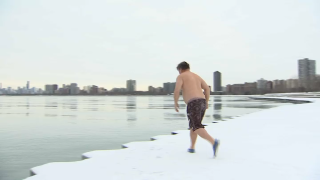
Monday saw some of the coldest temperatures in Chicago so far this year-- but that didn't stop Dan O'Conor, known affectionately as "The Great Lake Jumper," from front-flipping into dangerously cold Lake Michigan water.
"It feels amazing," the Lincoln Square resident told NBC 5 while on the Montrose steps during the early morning hours. "The full body rush of the endorphins trying to protect your body once they get shocked in this cold water."
The air temperature was in the teens, wind chills were below zero and the water temperature was just above freezing.
It's a dangerous practice, but O'Conor has been performing his jumps since June 2020.
Feeling out of the loop? We'll catch you up on the Chicago news you need to know. Sign up for the weekly Chicago Catch-Up newsletter here.
"Dan began jumping in the lake to curb the incessant negativity brought on by the pandemic, election year politics, and the rioting & looting," his website reads. "It was a simple way to clear his head and find a few minutes of zen."
He started documenting his jumps and eventually developed a following. Now, his daily jumps are intended not just for personal growth, but to raise awareness for the Chicago Independent Venue League, an advocacy group for independent performing arts venues in the city and a cause O'Conor is deeply passionate about.
Local
Monday's temperatures are far from the coldest O'Conor has jumped in. Notable, in December, he was seen jumping into Lake Michigan during the below-zero temperatures, with wind chills as low as -25 degrees.
Experts caution against following in O'Conor's footsteps, however.
According to the National Weather Service, 55-degree water "may not sound very cold, but it can be deadly."
"Plunging into cold water of any temperature becomes dangerous if you aren’t prepared for what the sudden exposure can do to your body and brain," the NWS states, adding that "cold water drains body heat up to four times faster than cold air."
"When your body hits cold water, 'cold shock' can cause dramatic changes in breathing, heart rate and blood pressure," the NWS continued. "The sudden gasp and rapid breathing alone creates a greater risk of drowning even for confident swimmers in calm waters. In rougher open water this danger increases. Unplanned immersion in cold water can be life-threatening for anyone without protection from the temperatures or a lifejacket to help you stay afloat. When Cold Shock and Hypothermia begin to impact your ability to think and act, lifejackets and floatation can create extra time for help to arrive or for you to get out of danger. Even the most experienced cold water surfers, swimmers or boaters know to prepare for the conditions."
Experts say those who do plan on jumping into such frigid waters should prepare themselves for such reactions.
Tips include:
- Always wear a life jacket in and around the water.
- Always dress for water temperature, not for air temperature. Some examples are:
- Wet suit
- Dry suit
- Immersion suit
- Survival suit
- Exposure coveralls
- Carry an Emergency Position Indicating Radio Beacon (EPIRB), personal locator beacon (PLB) or VHF Radio.
- File a float plan with someone you trust. The plan should include details about the trip, boat, passengers, towing or trailer vehicle, communication equipment, and emergency contacts.
- Know Before You Go:
- Be sure to check the weather and water temperature before you go out on the water
- If water is too cold, consider staying off/out of water until water is warmer



